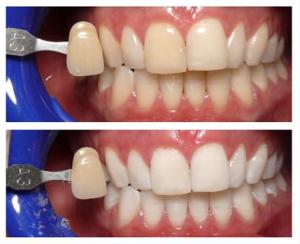What is tooth whitening?
Tooth whitening can be a very effective way of lightening the natural colour of your teeth without removing any of the tooth surface or damaging it. Usually the original shade of the tooth is whitened to a lighter colour, rather than being turned completely white. Teeth whitening is ideal for people who have healthy, unrestored teeth (no fillings) and gums. Individuals with yellow tones to their teeth respond best.

Why would I need my teeth whitened?
Maybe you’ve always wanted a beautiful white smile. Or your teeth have yellowed over time. Or you’re not happy with the staining that results from drinking coffee, tea or cola. Whatever your reason for wanting whiter teeth, you’re not alone.
Just like we all have different hair and skin colour, people also have different tooth colour. Some teeth are more yellow than others, while others yellow with aging. Your natural tooth colour can also be affected by many factors.
Surface stains and internal discoloration can be caused by:
- The natural aging process
- Using tobacco (smoked or chewed), drinking coffee, tea,colas or red wine, and eating pigmented foods such as cherries and blueberries
- Accumulation of plaque and tartar deposits
- Ingesting too much fluoride (more than 2 parts fluoride per millionparts water) when teeth are forming, which gives teeth a “mottled” look
- Treatment with the antibiotic tetracycline during childhood
- Trauma to the teeth that may cause a brown, gray or black color
There are many reasons for whitening your teeth, including:
The boost to your confidence and self-esteem that comes from a great smile
- A younger appearance
- A special event such as a wedding, job interview or class reunion
- To make a positive first impression on others
- To simply reverse years of everyday staining and yellowing
What does tooth whitening involve?
Professional bleaching is the most usual method of tooth whitening. Your dentist will assess you first to see whether tooth whitening is suitable for you. They will tell you about the options you have for tooth whitening and which will be the most suitable for you.
The most common type of whitening is called ‘dentist-supervised home whitening’. You will have trays made specially to fit into your mouth like gum-shields. The whitening gel is then put in the trays and you will be given a routine to follow at home like generally from a couple of hours a day to every day during the night for up to four weeks and even longer (depending on the degree of discoloration and desired level of whitening).
Another option is called ‘chair-side whitening’ and it provides the quickest way to whiten teeth.You will be told if you are suitable for the treatment, and your dentist will supervise it. First the dentist,will put a gel on your gums to protect them. They will then apply the whitening product to your teeth and then a light is shone onto the gel to speed up the whitening reaction.Usually it take multiple visits
The ‘active ingredient’ in the whitening product is usually hydrogen peroxide or carbamide peroxide. As the active ingredient is broken down, oxygen gets into the enamel and dentine of the teeth and the tooth colour is made lighter.
How long does home whitening take?
The total length of the home bleaching treatment can vary depending on how discoloured your teeth are and the shade you want to get to. It can usually be finished within two to four weeks. First, you will need up to four visits to the dentist. Your dentist will need to make a thin mouthguard and will take impressions for this at the first appointment. Once your dentist has started the treatment, you will need to continue the treatment at home. This means regularly applying the whitening product over two to four weeks, for 30 minutes to one hour at a time. The dentist will discuss with you exactly how long you should keep the tray in your mouth. It is important to follow the instructions that you are given to get the best result
How long does chair-side power whitening take?
Your dentist will need to assess your teeth to make sure that you are suitable for the treatment. Once it has been agreed, this procedure usually takes about one to two hours.
How long will my teeth stay whiter?
Teeth whitening is not permanent. People who expose their teeth to foods and beverages that cause staining may see the whiteness start to fade in as little as one month. Those who avoid foods and beverages that stain may be able to wait one year or longer before another whitening treatment or touch-up is needed.
The degree of whiteness will vary from individual to individual depending on the condition of the teeth, the level of staining, and the type of bleaching system used.
What are the side effects?
Some people may find that their teeth become sensitive to cold during or after the treatment. Others may have discomfort in the gums, a sore throat or white patches on the gum line. These symptoms are usually temporary and should disappear within a few days of the treatment finishing.
If any of these side effects continue you should go to your dentist.
